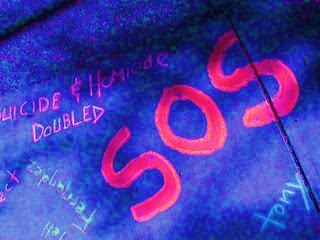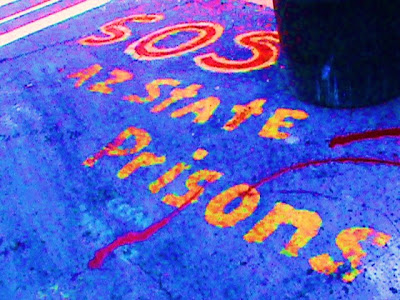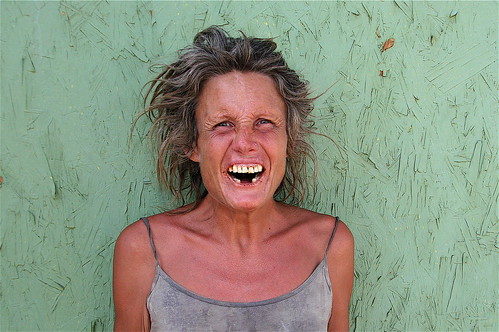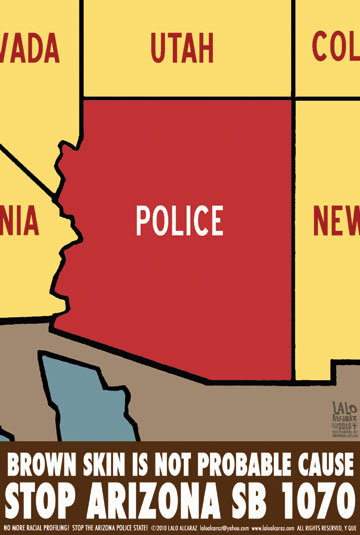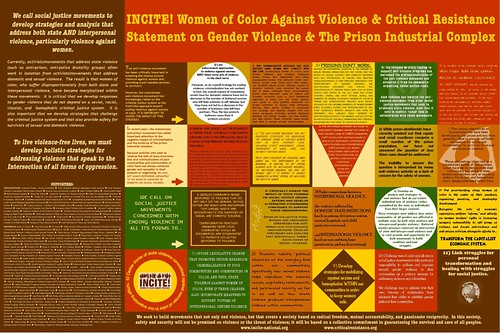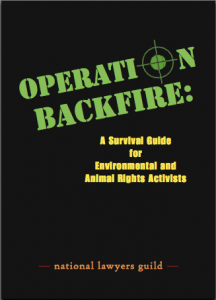Resistance Alley, Phoenix, AZ
(June 4, 2011)
January 26, 2012Honorable Gloria G. Ybarra
Phoenix Municipal Court
300 W. Washington St.
Phoenix, AZ 85003
Dear Judge Ybarra,
I sure hope you’re having a good day. This is kind of long.
I appeared in your court this morning prepared for trial, but the charge I contested was dropped so I ended up entering a plea unexpectedly. When you asked if I had anything to say before you entered your sentencing orders, I was kind of at a loss for words. I’m not very experienced at being prosecuted and don’t know what the proper procedure is, but since my thoughts have caught up with me now, in the still of the night, I hope it isn’t too late to enter them into my official court record. My crime was one of civil disobedience, so this action just isn’t finished until my statement for sentencing is in your hands. This is it.
I first began investigating and blogging about Arizona’s state prisons 2 ½ years ago when Marcia Powell died at Perryville Prison. Marcia was a 48 year-old mentally ill sex worker with a long history of drug and prostitution convictions and no family willing to claim her body once she was gone. She got 27 months for offering a cop a $20 blow job, doing much of it on the maximum security yard at Perryville. Marcia was supposed to be on a 10-minute suicide watch when she was left in an uncovered cage, largely ignored, for nearly four hours in the mid-day sun. It was at least 107 degrees that day. By the time someone noticed her unconscious on the ground, Marcia had defecated on herself, her organs were overheated and failing, and she had second degree burns all over her body. She went into a coma and passed away that night after the director of the Arizona Department of Corrections removed her from life support.
"Free Marcia Powell"
Remembering women who have died
from suicide and the violence of neglect
at Perryville state prison in Goodyear, AZ.
(November 18, 2011)
In the wake of Marcia’s death, 16 ADC employees were disciplined, 7 of whom were referred for criminal prosecution. No one ended up being charged, unfortunately; they all got their jobs back, in fact - except for the deputy warden, who was allowed to retire. Conflicting testimony was one reason no one was prosecuted - all the prisoners said the guards ignored Marcia’s pleas for water and relief from the sun; the guards had another story, of course. 10,000 pages of ADC investigative material, and the county attorney couldn’t make a single case out of it to hold anyone responsible - not even on a misdemeanor.
What happened to Marcia affected me deeply; there, but for the grace of God, went I.
I had been a teenage alcoholic and addict, and traded my sex a few times in my life to get high and get by. What I did as a teen to support my habit could have landed me in prison for 20 years - not rightfully so, mind you, but there nonetheless. I’m manic-depressive, as well - I’m just lucky I sobered up young, had good health insurance, and was never criminalized. The places I landed when I got into trouble all had heated bedrooms, not icy cold cells; we were traumatized and ill, not fundamentally bad; we were watched by psychiatric aides, not guards - and they didn’t lock us in cages to “wait us out” through the hours or days when we most wanted to die. I was blessed where Marcia wasn’t - I wasn’t that far from where she ended up though.
CRIPA AZ STATE PRISONS
E. Roosevelt St. Artwalk
(April 2, 2011)
Since then I’ve done extensive research on the violence and neglect in the Arizona Department of Corrections. When I discovered from an analysis of state records that the suicide and homicide rates doubled almost immediately under the current administration - which wasn’t interested in any dialogue about my research or conclusions - I began pushing the ACLU and the Department of Justice hard to intervene. For a long time, my appeals for help were met by silence or answered with form letters. The body count kept growing. I began to draw the names of the dead in murals on the sidewalks of justice - the legislature, courthouses, the police department and jail, and the ADC itself. I put down memorials in chalk all over town, then made postcards out of them and sent them across the country, calling media, lawmakers, activists - anyone I could think of for help. I even engaged the Phoenix police in my quest for assistance - quite often, in fact. None of the prisons I have issue with are in their jurisdiction, but I didn’t think that should stop them. They still could have helped open doors.
By last spring, when I finally painted the names of the dead across my alley, this was all deeply personal to me. Because I write about prison deaths, trying to humanize the prisoners as much as possible, I hear from their families a lot. Daily I’m exposed to the secondary trauma of working with survivors of prison violence; I live with the mother of a prisoner who was murdered by the West Side Crips at ASPC-Lewis two summers ago. Her son, Dana Seawright, was caught by the gang in a relationship with a Mexican prisoner, and by refusing to hurt someone to prove his loyalty to his own race, he died from a double hate crime for being true to himself. So the names I lay down on the earth in my murals are more than just criminals: I have spoken with many of their parents, lovers, teachers, siblings and kids. I know too many of their stories. Each time I add a new name to my list, I am acutely aware that - whatever their crime - it is still someone’s father or son, mother or sister, loved one or friend - someone I will be hearing from soon.
"Please Send Help"
Phoenix Police Parking Lot
(October 1, 2011)
On May 10, a meeting was held of the Maricopa County Commission of Justice System Intervention for the Seriously Mentally Ill. My analysis of suicides and homicides in the state prisons as of that date revealed that not only had they doubled under the current administration, but that prisoners with serious mental illness were at particularly high risk of being victims of both. I went to the meeting to tell them this, first stopping outside to chalk a memorial for them. The meeting was being held at the Old County Courthouse on W. Washington St.
I should note here that I’ve been exercising my free speech rights all over the sidewalks of Phoenix for a little over 2 years now; it rinses right off with the occasional desert rain. It took the Phoenix Police and County Attorney’s Office awhile to decide that my chalk alone didn’t warrant arrest or prosecution for criminal damage; bank security guards around town took a little longer to catch on. So I wasn’t too surprised when - not long into my project that morning - a deputy came running out of the courthouse waving his radio in the air and yelling “you can’t do that here!”
Old County Courthouse, Phoenix.
(May 10, 2011)
Before
I knew it, he took his foot and rubbed out the name of a young mentally
impaired boy who had killed himself just a week after arriving in adult
prison. Within minutes I was surrounded by deputies and daring them to
take me to jail for trespassing, furious about what I considered to be
desecration. Honestly, it was at that moment that I decided the next
time I put that kid’s name down on the ground, no one was going to be
able to smudge it out. The deputies backed down after the presiding
judge for the day told them to leave me be. They washed all the names
away as soon as I went inside.And so, a week or two later, I began to paint my back alley - first with a memorial spanning about 20 feet. Then, inspired by the graffiti of resistance around me (we have enlightened vandals in our neighborhood), I figured that if I was going to go to jail for criminal damage, I might as well do it right. I spent that next week decorating my alley and getting it ready for a small demo at June Artwalk, when I invited the Graffiti Detectives to arrest me. I even decked it out with anarchy symbols. I figured if I did enough damage I’d be charged with a felony, and could then take my case to Maricopa County’s Superior Court. There I planned to use my prosecution to confront the judiciary about packing all these people into prisons without taking any responsibility for assuring that there’s ample mechanisms for protecting their rights and lives behind bars. I wanted them to call for a judicial investigation into the homicides, suicides, and medical neglect in the state prisons. Seriously.
"Resistance Alley: SOS"
Phoenix, AZ
Artwalk
(June 4, 2011)
I don’t know why I thought my plan might work, or why I was willing to risk felony charges and state custody to try to get the courts more involved; it was kind of extreme. I think it had something to do with finding out at the time that my mother’s brain cancer was terminal, and feeling powerless to fight it - one friend observed that I picked fights with as many cops as I could around then. My mom’s illness aside, though, I felt like I was rushing another gunshot victim to the ER, day after day, and instead of escorting me there or summoning an ambulance, every time the police stopped me they just chided me for property damage - I wasn‘t finding that very helpful, and often told them so. Anyway, I actually wrote to the Superior Court - and chalked their walk a few times - and I don’t think they’re doing a thing.
I clearly wasn’t thinking things out too well when I planned to turn to criminal mischief in order to enlist their assistance - I was kind of manic last spring from not sleeping enough after Mom got sick. By mid-May I wasn’t all that organized or realistic about my strategies for instigating social change. I was just simmering with rage at the Department of Corrections, arguably the most heavily-fortified institution in Arizona, and easily the most well-funded. Director Chuck Ryan has a billion dollars at his disposal to fight me with - not to mention all the courts, cops, guns, laws and lawmakers in the state on his side - and I was out of ideas for soliciting help. I was utterly powerless to do anything myself, yet felt completely responsible for each new life lost that didn‘t have to be. For the death rates from suicide and homicide alone to normalize again, at least one in every two would have to be prevented. Among many in the mental health field, suicide is 100% preventable - that, at least, should be our goal.
Artwalk, Phoenix
(June 4, 2011)
I didn’t really care at the time about the possible consequences to my life of committing a felony or two; I also didn’t think my neighbors would mind much what I was doing. When I wasn’t grieving, I was just plain mad. “The City” could go to hell as far as I was concerned. The potential that my outdoor décor would cause anyone harm - beyond, perhaps, a little consternation - seemed pretty minimal next to the crimes of the evil empire I was deploying my artistry against. It still does, I have to say…though I guess that sounds a lot like I’m simply minimizing and justifying my own criminal conduct. That much I stand guilty of as well, then.
This may not be the wisest thing for me to say, since I still have to answer to you on this matter, but I’d still paint the town tomorrow if the circumstances seemed to call for it. I am, for the most part, an anarchist at heart, and want to see the art of resistance flourish all over the place. Phoenix is feeding a good number of people to the prisons and jails every day, and nothing about how the city has responded to this crisis has changed since I started. Not that I plan to repeat this action - I just don’t want to end up in Chuck’s custody myself. That would make what I do a whole lot harder.
Anyway, following my Artwalk demonstration, the Graffiti Detectives tried to accommodate my desire to get into Superior Court by folding all my charges into a single felony. I really appreciated that at the time, and told them as much. I think Bill Montgomery either didn’t want to be part of my theater, though, or he just knew I was a little compromised by certain stressors (I was actually sending him postcards of my graffiti trying to provoke him into prosecuting me sooner rather than later…). Or maybe I’m giving him too much credit for caring one way or the other, and his people just thought I’d be a nuisance to deal with so they dumped me on your court instead. I’ve picked on him and his prosecutors in my blogs before, though - I would have thought they’d love to get their hands on me. That speaks well of their professionalism, I suppose.
Anarchy: No Justice/ No Peace
Resistance Alley Artwalk
just to be provocative
(June 4, 2011)
In any case, I’m grateful not to be facing prison for even a day or the brand of “felon” for the rest of my life. Sgt. Kaddatz and Detective Rowe could have actually lodged more complaints against me than they did because I vandalized my alley again later that month, impatient for them to file the first set of charges so I could take my fight to court. I’ve chilled out since then, by the way. I still chalk sidewalks - I just stay away from painting them. The Graffiti Detectives showed a lot of restraint, I thought - especially considering how hard a time I gave them when they didn’t arrest me. I didn’t think my intersecting privileges should exempt me from what any young Latino male might go through in my shoes, so I got a little provocative and baited them a few times. I’m kind of grateful to be a well-educated middle-class white woman today, though, because if I was anyone else I would have probably been tasered or shot by now.
"Prisoners Dying: SOS"
The Phoenix Center
(April 23, 2011)
I’ve come down a lot since then, of course - otherwise you would have been seeing me in court in pink socks and stripes. I got really depressed after my Mom died this summer, and my financial situation deteriorated so my energy has gone increasingly into basic survival. My court proceedings this fall and winter have been tedious and anti-climactic, to say the least - I haven’t had the kind of manic drive to orchestrate what I initially envisioned I‘d be doing with all this. One of the problems with my bi-polar disorder is that the fallout from my grandiosity and expansiveness usually catches up to me just as I’m crashing the hardest and am the least able to explain myself - I get way in over my head, and can‘t account for how I got there. I actually haven’t had much to say of late, believe it or not.
"Demolish the Prisons"
ACLU-AZ, Phoenix
(April 26, 2011)
Since my protest in June, the ACLU and the Prison Law Office have at least decided to file suit against the AZ Department of Corrections over the medical and psychiatric neglect of their prisoners, the abuse of solitary confinement, and the skyrocketing suicide rates under Chuck Ryan. I think my research and imprisoned correspondents were more influential in helping them take that step than all my protests and postcards were - but the fact that there’s an emerging and impassioned prisoner rights movement here must have helped convince them that Arizona isn’t a lost cause. That’s part of what I do with my blogs: I bear witness, and try to make this struggle - and the people we’ve relegated to the darkness - more visible.
MLK Day Memorial
Margaret T. Hance Park, Phoenix
(January 16, 2011)
I’m afraid the problem behind the escalating violence in Arizona’s prisons lies in the institutional culture that‘s been cultivated there, and how the ADC does business these days - not in who their customers are. Their policies and programs (or lack thereof), and their fees and penalties all reflect more than indifference - there’s a deep and pervasive contempt for prisoners and their families under this regime. Chuck Ryan himself is a bully, encouraging subordinates to behave the same way towards their staff and prisoners alike. He actually had a mentally ill Supermax prisoner prosecuted for arson who tried to kill himself by setting himself on fire after begging for a year to get out of solitary. The court added a year and a half onto his existing 10-year sentence, and even ordered that the guy pay the state restitution for his medical care in the amount of $1.8 million. He was prosecuted while chained to a bed and recovering from burns over 80% of his body.
Who will represent the dead?
Arizona State Legislature, Phoenix
(February 22, 2011)
Anyway, I still have some work to do on the prisons, but will refrain from engaging in acts of civil disobedience that may have a negative impact on my neighbors or community. As for the taxpayer dollars involved in policing and prosecuting me - really, I think the money would have been much better spent by the city getting someone to investigate the state prisons like I asked them to in the first place. The Phoenix Police could have at least contacted DPS or the DOJ to express their concern about the homeless mentally ill people they’re helping send off to prison - where they’re being assaulted, castrated and killed - so it’s not just my voice falling on deaf ears about all this (there are a lot of us clamoring out here these days, actually). A phone call requesting that the proper law enforcement agency conduct an investigation is all I’ve asked them to make. Instead, today there’s a few more lawsuits against the ADC, a few more names for my murals, and a few more families grieving their dead than there were when I demonstrated in June. I’m just a civilian needing law enforcement assistance or the persuasive power of an informed judiciary - why is that so hard to get here?
I’m not too happy with either the courts or the cops in this state, frankly. A whole squad of detectives turned out to protect the pavement and dumpsters from my paintbrush at Artwalk in June, yet none of them will try to help me stop this death toll from climbing. If I presented evidence identifying suspects in an unsolved homicide in Buckeye or Tucson proper - or non-law enforcement corruption at the state level - they would have facilitated interagency communication about it without hesitation. Prisoners draw silence and blank stares, though. A well-placed phone call six months ago could have saved lives - still can, really. Here we are, though, half a year later, and instead of nailing the folks with the guns and badges and power who are doing real criminal damage to people‘s lives, the city is still prosecuting me and ignoring the evidence that I‘ve compiled against far more guilty parties.
What is wrong with this place?
"Criminal Damage"
Resistance Alley, Phoenix
(June 10, 2011)
So is the state constitution. We need to amend the Victim’s Bill of Rights to include prisoners in the definition of “victim,” or we’ll never get justice for victims of police and prison violence, neglect and abuse. Persons “in custody for an offense” are exquisitely vulnerable to trauma and victimization, and will continue to be so as long as we diminish their rights that way. They and their survivors (in cases resulting in death) are the only class of people excluded from the rights afforded all other crime victims. That’s only because the perpetrators in those cases are most likely cops, not because one becomes suddenly less deserving of life or safety once taken into state custody. I can’t believe that most Arizonans - if they knew about Shannon Palmer, Tony Lester, Marcia Powell, Brenda Todd, Susan Lopez, Duron Cunningham, and Dana Seawright, to name a few - would continue to deny prisoners and their loved ones the same rights they would preserve for themselves and their children. Maybe that’s the next place I’ll go with my murals - a public education campaign of a slightly different kind.
Well, I guess that’s my statement, for better or worse - the one I would have read at sentencing if I saw it coming today. Sorry it’s so long. I hope it’s not too late to enter it into my court record. It’s also going up on my blogs. It’s just intended to be explanatory, not to excuse me in any way. I was ready to take full responsibility for everything I did - I really was prepared to go to prison if I needed to, in order to advance my cause. Thank God (and the County Attorney‘s Office, of course) that I didn’t.
In any case, I didn’t mean to wait until after you sentenced me to articulate why I did what I did, and what I am and am not remorseful for (yes, my neighbor's wall, no, the alley and dumpster - I made great improvements to the scene). Maybe that’s not very fair of me; I think you’re supposed to get the last word in. Hopefully it wouldn‘t have made you any less inclined to cut me loose with only restitution and community service. You can always take it out of me the next time, though - I’ll be back again with the Occupiers soon. I was arrested filming the police at their Hance Park protest this fall…
Abolish the Phoenix Camping Ordinance!
Margaret T. Hance Park, Phoenix
(October 15, 2011)
I guess there’s one more thing I need to say, actually - whether or not it gets me into trouble. Please try not to send any more mentally ill people like me and my brother to Joe’s jail. He’s killing us in there, too, you know - some violently, like Marty Atencio, and some quietly - like those who cycle in and out of there for years dying inside, unnoticed. We aren’t “safer” or getting “cared for” in there as opposed to being on the streets, for the most part. Rather, behind bars we are in constant danger of violence, trauma and despair.
I don’t know why there isn’t anything the judiciary can do about guys like Arpaio and Ryan, since you entrust us so confidently to their custody. Once you get our fingerprint and designate us as property of the state, it seems you’re pretty much done with us, too. Surely if you can order cops into our private homes to enforce drug laws, you can send them into our public jails and prisons to enforce important laws that protect vulnerable persons from neglect and abuse, and promote the civil rights of all. It would seem to be your legal duty, in fact, to make sure that the places you lock us away in for our punishment - or our protection - aren’t routinely violating our rights to health, safety, sanity, and life, and that when you do learn of such things, you have them investigated further, or you dig into it yourself. We deserve to be treated with some humanity, whatever our crime.
Sadly, I heard a Municipal Court judge this week say she couldn‘t order or otherwise compel the jail to give a mentally ill prisoner his meds, even though his attorney said he was decompensating rapidly without them. That’s deeply troubling. She can’t convince or coerce the jail to give him essential medical care, but she’s empowered to imprison him for the next nine months on a Rule 11 getting restored to the level of competency that the MCSO destroyed. He would be punished if he was non-compliant with treatment in there, but the jail staff get off hurting him scott free. That’s stealing a piece of a man’s life from him because he’s ill, not because he’s a criminal. He hadn’t even been sentenced. How does that resemble justice? If that judge can’t have a clerk call Magellan or Correctional Health Services and get that guy his injection before he gets sicker, then she should at least have ordered someone to make a civil rights complaint on his behalf - not just leave him to unravel in jail between hearings like that. That’s real criminal damage.
"The Trial of Officer Kevin Gerster"
Maricopa County Central Courthouse, Phoenix
(March 11, 2011)
So, that’s basically what my crime - this particular crime of expression, anyway - was all about. While I take responsibility for making amends where I offended and restitution where I harmed, I don’t think I’m the one who needs to be rehabilitated here. Please share my concerns with your colleagues and ask them to be more pro-active in the future when it comes to the well-being of the vulnerable people they order confined in the custody of those who have already shown they will neglect, torment and kill us with startling frequency.
"Please stop killing your prisoners"
Arizona Department of Corrections:
Central Office, Phoenix
(November 22, 2011)
Thank you for your time and patience with me. I wouldn’t have been so candid with most judges, I don’t think, so I sure hope you’re as cool as you seem to be; I mean no disrespect. If anything, take it as a sign that I trust you to be able to handle it, which is saying a lot for someone with your kind of power.
Take care,
Peggy Plews
Prison Abolitionist
Abandoned Tent City Guard Tower
Maricopa County Jail, Phoenix
(April 4, 2011)




